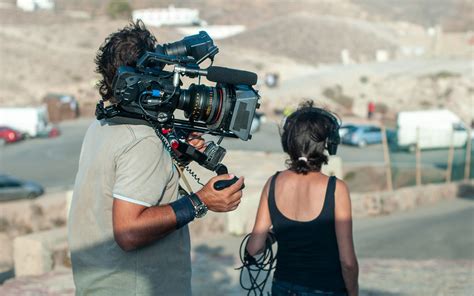Are you fascinated by the world of documentary filmmaking? Whether you’re a budding filmmaker or simply enjoy watching documentaries, understanding the intricacies of this genre can enhance your appreciation for the craft. In this blog post, we’ll delve into the field of documentary filmmaking and explore the various aspects that make it such a powerful and impactful medium. From the basics of documentary filmmaking to the different types of documentaries and the ethical considerations that come into play, we’ll take a comprehensive look at what it takes to create a compelling and engaging documentary. Join us as we uncover the power of visual storytelling, the importance of research and pre-production, and the techniques that cinematographers, interviewers, and sound designers use to capture authenticity and draw out compelling narratives. We’ll also discuss the role of editing in crafting a coherent and engaging documentary, as well as the potential impact and influence that documentaries have in sparking social change. Whether you’re an aspiring filmmaker or simply a documentary enthusiast, this blog post will provide you with valuable insights into the bigger picture of documentary filmmaking.
Table of Contents
Understanding the Basics of Documentary Filmmaking
Documentary filmmaking is a powerful storytelling medium that has the ability to inform, inspire, and provoke thought. Whether you are an aspiring filmmaker or someone who simply appreciates the art of documentary, understanding the basics of documentary filmmaking is essential to fully appreciate and critically analyze this genre.
One of the key types of documentaries is the observational style, which aims to capture real-life events and interactions without any interference from the filmmaker. This approach often results in a raw and authentic representation of the subject matter, allowing viewers to feel as though they are experiencing the events firsthand.
Another important aspect of documentary filmmaking is research and pre-production, which involves laying the foundation for a successful documentary. This stage entails conducting thorough research, identifying potential interview subjects, and scouting locations to ensure that the film accurately represents the chosen subject matter.
Cinematography techniques also play a crucial role in capturing authenticity in documentaries. The use of natural lighting, handheld cameras, and long takes can add a sense of realism to the film, making viewers feel as though they are right in the midst of the action.
Types of Documentaries: From Observational to Participatory
Documentaries come in various forms, each with its own unique approach to storytelling. One of the most common categorizations of documentaries is based on the level of involvement of the filmmaker in the subject matter. Observational documentaries, as the name suggests, take a hands-off approach, allowing the events to unfold naturally without any interference from the filmmaker. This technique aims to capture authentic and unmediated moments, often using long takes and minimal editing to convey a sense of realism.
On the other hand, participatory documentaries involve a more active role from the filmmaker, who may interact with the subjects or even become a part of the narrative. This approach allows for a more personal and subjective exploration of the topic, as the filmmaker’s presence becomes an integral part of the storytelling.
Both observational and participatory documentaries have their own strengths and weaknesses, and the choice between the two depends on the filmmaker’s objectives and ethical considerations. While observational documentaries strive for objectivity and authenticity, participatory documentaries embrace subjectivity and personal engagement, blurring the lines between filmmaker and subject.
Ultimately, the distinction between observational and participatory documentaries reflects the diverse range of storytelling techniques available to documentary filmmakers, each offering a different perspective on the world around us.
The Power of Visual Storytelling in Documentaries
Visual storytelling is a powerful tool in the world of documentary filmmaking. It allows filmmakers to convey emotions, convey information, and immerse their audience in the subject matter in a way that words alone cannot achieve.
Through the use of cinematography, camera angles, and visual composition, documentarians can create a compelling and immersive experience for their viewers. The careful selection of shots and the use of visual metaphors can communicate complex ideas and evoke deep emotional responses from the audience.
Whether it’s capturing the natural beauty of a landscape or the raw emotion on a subject’s face, visual storytelling has the power to transport the audience into the heart of the documentary’s narrative.
Documentaries that master the art of visual storytelling are able to leave a lasting impact on their viewers, driving home the themes and messages of the film in a way that lingers long after the credits have rolled.
Documentary Ethics: Balancing Objectivity and Subjectivity
When creating a documentary, it is important to consider the ethical implications of balancing objectivity and subjectivity. Documentary ethics require filmmakers to navigate the fine line between presenting a truthful representation of reality and incorporating their own perspectives and biases into the narrative.
Objectivity in documentaries involves presenting facts and information without distortion or bias. This requires careful research, fact-checking, and a commitment to representing all sides of a story. Subjectivity, on the other hand, allows filmmakers to express their unique point of view and emotional connection to the subject matter. It can add depth and personal insight to the storytelling process.
One way to maintain ethical balance in documentary filmmaking is to be transparent about the filmmaker’s perspective. This can be achieved through on-screen interviews or narration that acknowledges the subjective nature of the storytelling. Additionally, consulting with experts or individuals with diverse viewpoints can help ensure a well-rounded portrayal of the subject matter.
Ultimately, ethical documentary filmmaking involves a constant evaluation of the choices made throughout the production process. By critically examining the impact of subjective decisions on the overall narrative, filmmakers can strive to maintain credibility and integrity in their work.
Research and Pre-production: Laying the Foundation for a Successful Documentary
Before the cameras start rolling and the interviews begin, a successful documentary starts with thorough research and meticulous pre-production planning. This crucial stage is where the foundation for the entire documentary is laid, setting the tone, direction, and scope of the project.
First and foremost, in-depth research is essential to gaining a comprehensive understanding of the subject matter. Whether it’s a social issue, a historical event, or a cultural phenomenon, the more you know, the better equipped you are to tell a compelling story. This involves immersing oneself in books, articles, and any existing footage related to the topic.
Equally important is the pre-production phase, where key decisions are made regarding the story structure, the visual style, and the overall creative approach. This is the time to collaborate with a skilled team of producers, researchers, and cinematographers to ensure that the vision for the documentary is well-defined and attainable.
Ultimately, the quality and impact of a documentary can be traced back to the research and pre-production process. By laying a strong foundation at this stage, filmmakers can navigate the challenging terrain of documentary storytelling with clarity and purpose.
Cinematography Techniques for Capturing Authenticity in Documentaries
When it comes to creating a compelling and authentic documentary, the role of cinematography cannot be understated. The cinematography techniques used in documentaries play a crucial role in capturing the essence of the subject matter and conveying it to the audience in a way that feels real and immersive.
One cinematography technique that is often used to capture authenticity in documentaries is verite or observational style. This approach involves the filmmaker being a fly on the wall, capturing events as they unfold without any intervention or interference. This technique allows for the most natural and unfiltered portrayal of the subject matter.
Another important cinematography technique for capturing authenticity in documentaries is the use of natural light. Natural light has the ability to create a sense of authenticity and realism that artificial lighting simply cannot replicate. It can also add to the immersive and intimate feeling of the documentary, making the audience feel like they are experiencing the events firsthand.
Furthermore, the use of handheld cameras and unconventional shooting angles can also contribute to capturing authenticity in documentaries. By forgoing traditional tripod-mounted shots, filmmakers are able to immerse the audience in the action and make them feel like they are right there in the moment.
Interviewing Techniques: Drawing Out Compelling Personal Narratives
One of the most important aspects of documentary filmmaking is the art of interviewing. Through skillful interviewing techniques, filmmakers are able to draw out compelling personal narratives from their subjects, ultimately creating a rich and engaging documentary. The ability to connect with interviewees and encourage them to share their stories is essential for capturing the true essence of a documentary.
Conducting effective interviews requires a deep understanding of the subject matter and a genuine curiosity about the individual being interviewed. Listening actively and asking open-ended questions are key strategies for eliciting detailed and emotionally resonant responses.
When interviewing for a documentary, it is crucial to create a comfortable and safe environment for the interviewee. Building rapport and establishing trust can make all the difference in the depth and authenticity of the stories shared. It’s important to remember that the interviewee is entrusting the filmmaker with their personal experiences, and it is a filmmaker’s responsibility to honor that trust.
Additionally, employing active listening and follow-up questions can lead to more revealing and insightful responses. By allowing the interviewee to take the lead and share their experiences in their own words, filmmakers can capture the raw emotion and authenticity that make for powerful storytelling in documentaries.
The Role of Sound Design in Enhancing Documentary Narratives
Sound design plays a crucial role in enhancing the impact and effectiveness of documentary narratives. Through the skillful use of sound elements, such as music, ambient noise, and voice-over, filmmakers can evoke emotional responses, create atmosphere, and guide the audience’s perception of the story being told.
One of the key ways in which sound design enhances documentary narratives is by providing context and depth to the visuals. For example, the use of location-specific ambient noise can transport viewers to the setting of the documentary, making them feel more immersed in the story. Additionally, the strategic placement of music can underscore emotional moments or heighten the tension in a scene, adding an extra layer of emotional impact to the storytelling.
Furthermore, sound design can also be used to establish a rhythm and pacing within the documentary. The judicious use of silence, the careful arrangement of dialogue and narration, and the strategic incorporation of sound effects can all contribute to the overall flow and structure of the narrative, ensuring that the audience remains engaged and connected to the story.
Ultimately, sound design is a powerful tool that documentary filmmakers can harness to enhance the storytelling experience. When used thoughtfully and creatively, sound can elevate the emotional resonance of a documentary, create a more immersive viewing experience, and leave a lasting impression on the audience.
Editing Principles: Crafting a Coherent and Engaging Documentary
When it comes to creating a compelling and impactful documentary, the editing process plays a crucial role in shaping the narrative and engaging the audience. One of the key editing principles in documentary filmmaking is maintaining a coherent storyline while incorporating various perspectives and elements to craft a seamless and engaging final product.
By carefully selecting and sequencing footage, a documentary editor is able to construct a cohesive and compelling narrative that effectively communicates the intended message or story. This involves making decisions about which footage to include, the pacing of the editing, and the overall structure of the documentary.
In addition to structuring the narrative, editing also involves the use of visual and audio elements to enhance the storytelling. This can include the use of music, sound effects, graphics, and other elements to create a multi-sensory experience for the audience.
Moreover, a skilled documentary editor must also be mindful of maintaining ethical standards throughout the editing process. This means being truthful to the source material and avoiding manipulative tactics that could compromise the integrity of the documentary.
Impact and Influence: How Documentaries Spark Social Change
Documentaries have the power to impact and influence society in profound ways. Through the art of storytelling, documentaries have the ability to shed light on important social issues, challenge the status quo, and inspire meaningful change. Whether it’s a documentary about environmental conservation, social justice, or human rights, these films have the potential to spark conversations and ignite movements.
One of the key ways in which documentaries spark social change is by bringing attention to pressing issues that may otherwise go unnoticed. By presenting the facts, personal narratives, and expert opinions, documentaries can educate audiences and raise awareness about topics that are often overlooked by mainstream media.
Furthermore, documentaries have the power to humanize complex issues by putting a face and a story to statistics and headlines. By sharing the personal experiences of those affected by social injustice or environmental degradation, documentaries can evoke empathy and compassion, prompting viewers to take action and make a difference in their communities.
Moreover, documentaries can serve as a catalyst for social change by providing a platform for marginalized communities to share their stories and advocate for their rights. By amplifying the voices of those who are often silenced, documentaries can empower individuals and communities to demand justice and equality.





